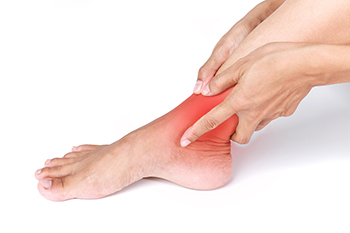Connect With Us
Blog
Items filtered by date: February 2022
What Is Morton’s Neuroma?
 Morton’s neuroma refers to the thickening of the nerve tissue between the third and fourth toes. This thickening is caused by compression and irritation of the nerve. If left untreated, the nerve may become permanently damaged. Morton’s neuroma can develop from wearing shoes that are too tight in the toes and from shoes that have high heels. Running or other activities that involve repetitive irritation to the ball of the foot can also lead to Morton’s neuroma. Symptoms of this condition can include tingling, burning, numbness, and pain in the foot. Some have described the unique sensation of Morton’s neuroma as feeling like a pebble is stuck in the ball of the foot or like there is something stuck in their shoe like a scrunched-up sock. Symptoms typically begin gradually and may worsen over time. For more information about Morton’s neuroma, please consult with a chiropodist.
Morton’s neuroma refers to the thickening of the nerve tissue between the third and fourth toes. This thickening is caused by compression and irritation of the nerve. If left untreated, the nerve may become permanently damaged. Morton’s neuroma can develop from wearing shoes that are too tight in the toes and from shoes that have high heels. Running or other activities that involve repetitive irritation to the ball of the foot can also lead to Morton’s neuroma. Symptoms of this condition can include tingling, burning, numbness, and pain in the foot. Some have described the unique sensation of Morton’s neuroma as feeling like a pebble is stuck in the ball of the foot or like there is something stuck in their shoe like a scrunched-up sock. Symptoms typically begin gradually and may worsen over time. For more information about Morton’s neuroma, please consult with a chiropodist.
Morton's neuroma can be highly uncomfortable. If you are experiencing the symptoms of Morton's neuroma, please consult with one of our chiropodists from West Toronto Foot & Ankle Clinic Inc. . Our chiropodist will assess your condition and provide you with quality foot and ankle treatment.
What Is a Morton’s Neuroma?
Morton’s neuroma is a condition in which a nerve located in the ball of the foot between the third and fourth toes thickens due to compression or irritation. Common causes of Morton’s neuroma include wearing shoes with high heels or narrow toe boxes, participating in running or court sports, an injury or trauma to the area, or pressure being placed on the nerve from foot deformities such as bunions or hammertoes. Left untreated, Morton's neuroma may result in permanent nerve damage.
Symptoms
Symptoms of Morton’s neuroma often start gradually and worsen over time. Typical symptoms include:
- Foot pain
- Tingling, burning, or numbness in the affected foot
- The unique sensation that something is inside the ball of the foot or that there is something stuck in your shoe while walking
Treatment
Non-surgical treatments for this condition may include padding or icing the affected foot, wearing an orthotic device, modifying activities or shoes to reduce pressure on the foot, and taking medications or getting injections to reduce pain and inflammation. Surgery may be needed if non-surgical treatments are ineffective.
If you have any questions, please feel free to contact our office located in . We offer the newest diagnostic and treatment technologies for all your foot care needs.
Are You Suffering From Ingrown Toenails?
What Causes Ingrown Toenails?
 Ingrown toenails are a common condition in which the outer edge of a toenail grows into the surrounding skin. This typically occurs on the big toe and can cause pain, swelling, and redness in the affected area. Ingrown toenails can be caused by wearing tight, ill-fitting shoes, shoes with pointed toes, and shoes with high heels, which can compress the toes and force the toenails to curve into the skin. Trimming the toenails improperly can also cause them to grow into the skin. Toenails should be trimmed straight across, without rounding the edges of the nail. Injury to the toenail, fungal infections, taking certain medications, and having an irregular nail shape can also lead to ingrown toenails. If you suffer from painful ingrown toenails or are prone to them, it is recommended that you seek the care of a chiropodist.
Ingrown toenails are a common condition in which the outer edge of a toenail grows into the surrounding skin. This typically occurs on the big toe and can cause pain, swelling, and redness in the affected area. Ingrown toenails can be caused by wearing tight, ill-fitting shoes, shoes with pointed toes, and shoes with high heels, which can compress the toes and force the toenails to curve into the skin. Trimming the toenails improperly can also cause them to grow into the skin. Toenails should be trimmed straight across, without rounding the edges of the nail. Injury to the toenail, fungal infections, taking certain medications, and having an irregular nail shape can also lead to ingrown toenails. If you suffer from painful ingrown toenails or are prone to them, it is recommended that you seek the care of a chiropodist.
Ingrown toenails may require medical attention. If you have significant pain or notice signs of infection from an ingrown toenail, please consult with one of our chiropodists from West Toronto Foot & Ankle Clinic Inc. . Our chiropodist will assess your condition and provide you with quality foot and ankle treatment.
What Is an Ingrown Toenail?
An ingrown toenail occurs when the edges of a toenail grow into the surrounding skin. The toenails of the big toe are usually affected, however, an ingrown toenail can happen on any toe. Sometimes, the area can become infected leading to potentially serious complications. The ingrown toenail may be caused by improper trimming of the toenail, wearing ill-fitting shoes, or injury to the nail.
Symptoms
The symptoms of an ingrown toenail include:
- Pain
- Swelling
- Redness
- Warmth
- Pus or drainage from the affected nail or a fever may indicate an infection of the area.
Treatment
Treatment depends on the severity of the ingrown toenail. In less severe cases, home treatment may be adequate. Soaking the affected foot in warm water and gently lifting the nail from the skin with a piece of clean cotton can help. In more severe cases, you may need to use topical or oral antibiotics to treat an infection. Surgical removal of the ingrown toenail may be required if more conservative treatments fail.
Ingrown toenails may be prevented by wearing well-fitted shoes and properly trimming the toenails. Toenails should be trimmed straight across and not too short when using nail clippers.
If you have any questions, please feel free to contact our office located in . We offer the newest diagnostic and treatment technologies for all your foot care needs.
Which Foot Conditions Are Common in Children?
 Some foot conditions are not only experienced by adults but also by children. Foot conditions that are common in children include ingrown toenails, plantar warts, flat feet, and heel pain. Ingrown toenails occur when the edge of a toenail grows into the surrounding skin. This can cause pain and become infected when left untreated. Plantar warts are warts that grow on the bottom of the feet due to a viral infection. They typically appear as a circular area of thickened skin with black dots in the center and can be painful when pressure is applied to them. Flat feet are feet that have minimal or no arches in the middle of the sole of the foot. Flat feet typically don’t cause symptoms but may require treatment if your child complains of foot or leg pain or difficulty walking. Heel pain in children can have a variety of underlying causes, including plantar fasciitis and Sever’s disease. Sever’s disease typically occurs in the growth plate of the heel and affects children who are active and 8 to 14 years of age. If your child complains of any type of foot pain, it is recommended that you take them to a chiropodist for proper treatment.
Some foot conditions are not only experienced by adults but also by children. Foot conditions that are common in children include ingrown toenails, plantar warts, flat feet, and heel pain. Ingrown toenails occur when the edge of a toenail grows into the surrounding skin. This can cause pain and become infected when left untreated. Plantar warts are warts that grow on the bottom of the feet due to a viral infection. They typically appear as a circular area of thickened skin with black dots in the center and can be painful when pressure is applied to them. Flat feet are feet that have minimal or no arches in the middle of the sole of the foot. Flat feet typically don’t cause symptoms but may require treatment if your child complains of foot or leg pain or difficulty walking. Heel pain in children can have a variety of underlying causes, including plantar fasciitis and Sever’s disease. Sever’s disease typically occurs in the growth plate of the heel and affects children who are active and 8 to 14 years of age. If your child complains of any type of foot pain, it is recommended that you take them to a chiropodist for proper treatment.
If your child is experiencing foot or ankle pain, please consult with one of our chiropodists from West Toronto Foot & Ankle Clinic Inc. . Our chiropodist will assess your condition and provide you with quality foot and ankle treatment.
Common Causes of Foot Pain in Children
While children can experience many of the same foot problems as adults do, some foot problems may be more common during childhood.
Causes of foot pain in children can include:
- Deformities that are present from birth, such as flat feet or clubfoot
- Sever’s disease, which is an inflammation of the growth plate in the heel bone
- Various sports injuries, such as sprains and fractures
- Ingrown toenails
- Athlete’s foot
- Plantar warts
Prevention
It is important to look after the health of children’s feet in order to prevent future problems from arising. Keep your child’s feet clean and dry, trim their toenails regularly, ensure their shoes fit properly, and keep a watchful eye on any symptoms of foot pain, such as limping. If you notice any symptoms or if your child complains of foot pain, a chiropodist can help.
If you have any questions, please feel free to contact our office located in . We offer the newest diagnostic and treatment technologies for all your foot care needs.
What Is Tarsal Tunnel Syndrome?
 The tarsal tunnel is a narrow space on the inside of the ankle that contains arteries, veins, tendons, and nerves. Tarsal tunnel syndrome occurs when one of these nerves, the posterior tibial nerve, is squeezed or compressed. This can occur due to an abnormal structure in the area such as a cyst or bone spur, an injury that causes inflammation such as an ankle sprain, or diseases like arthritis and diabetes. Symptoms of tarsal tunnel syndrome are an electric shock-like tingling or burning sensation on the inside of the ankle or bottom of the foot, as well as numbness and shooting pain. Treatments for this condition include resting and icing the affected foot, taking oral medications to reduce pain and inflammation, bracing or immobilizing the foot, and wearing specialized shoes or orthotics devices. Left untreated, tarsal tunnel syndrome may cause permanent nerve damage. If you have symptoms of tarsal tunnel syndrome it is recommended that you see a chiropodist for treatment.
The tarsal tunnel is a narrow space on the inside of the ankle that contains arteries, veins, tendons, and nerves. Tarsal tunnel syndrome occurs when one of these nerves, the posterior tibial nerve, is squeezed or compressed. This can occur due to an abnormal structure in the area such as a cyst or bone spur, an injury that causes inflammation such as an ankle sprain, or diseases like arthritis and diabetes. Symptoms of tarsal tunnel syndrome are an electric shock-like tingling or burning sensation on the inside of the ankle or bottom of the foot, as well as numbness and shooting pain. Treatments for this condition include resting and icing the affected foot, taking oral medications to reduce pain and inflammation, bracing or immobilizing the foot, and wearing specialized shoes or orthotics devices. Left untreated, tarsal tunnel syndrome may cause permanent nerve damage. If you have symptoms of tarsal tunnel syndrome it is recommended that you see a chiropodist for treatment.
Tarsal tunnel syndrome can cause pain and progress over time. If you are experiencing any symptoms of tarsal tunnel syndrome, please consult with one of our chiropodists from West Toronto Foot & Ankle Clinic Inc. . Our chiropodist will assess your condition and provide you with quality foot and ankle treatment.
What Is Tarsal Tunnel Syndrome?
Tarsal tunnel syndrome is a condition in which the posterior tibial nerve, which is located within a structure called the tarsal tunnel on the inside of the ankle, is squeezed. Compression of the posterior tibial nerve can be caused by injuries, such as ankle sprains, systemic diseases like diabetes or arthritis, strain on the tarsal tunnel due to flat feet, or an enlarged structure like a cyst squeezing the nerve.
Symptoms
Symptoms of tarsal tunnel syndrome can appear suddenly and are generally worsened by physical activity.
Common symptoms include:
- Tingling, burning, or electrical shock sensation on the inside of the ankle or bottom of the foot
- Numbness
- Shooting pain
Diagnosis
Tarsal tunnel syndrome is diagnosed through physical examination. If initial treatment is ineffective, imaging or nerve studies may also be necessary.
Treatment
Nonsurgical treatments for tarsal tunnel syndrome include resting and icing the foot, bracing or immobilizing the foot, wearing an orthotic device, modifying your footwear, and taking medications to relieve pain. Surgery may be needed if nonsurgical treatments are ineffective.
If you have any questions, please feel free to contact our office located in . We offer the newest diagnostic and treatment technologies for all your foot care needs.
Blog Archives
- November 2025
- October 2025
- September 2025
- August 2025
- July 2025
- June 2025
- May 2025
- April 2025
- March 2025
- February 2025
- January 2025
- December 2024
- November 2024
- October 2024
- September 2024
- August 2024
- July 2024
- June 2024
- May 2024
- April 2024
- March 2024
- February 2024
- January 2024
- December 2023
- November 2023
- October 2023
- September 2023
- August 2023
- July 2023
- June 2023
- May 2023
- April 2023
- March 2023
- February 2023
- January 2023
- December 2022
- November 2022
- October 2022
- September 2022
- August 2022
- July 2022
- June 2022
- May 2022
- April 2022
- March 2022
- February 2022
- January 2022
- December 2021
- November 2021
- October 2021
- September 2021
- August 2021
- July 2021
- June 2021
- May 2021
- April 2021
- February 2021
- January 2021

